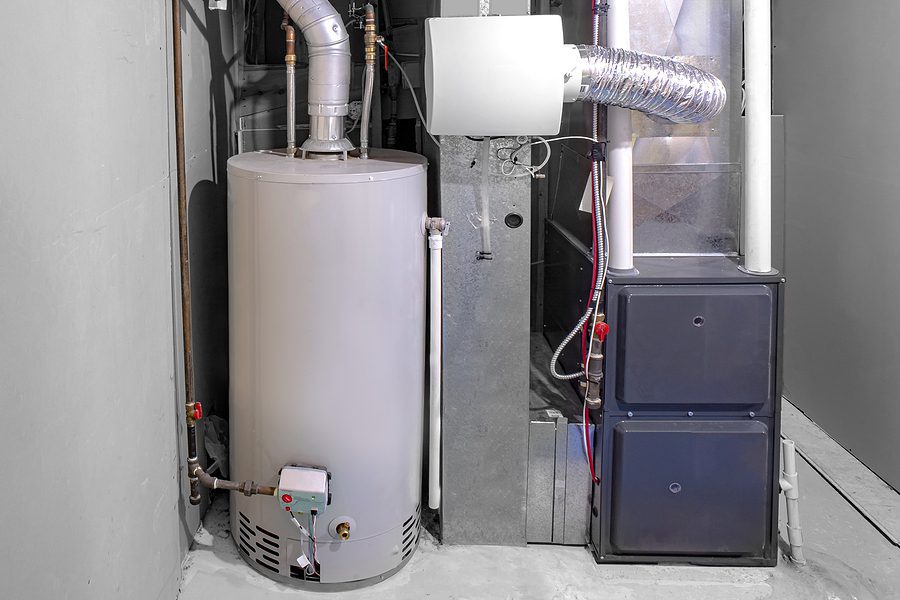
Several seasonal maintenance tasks are doable for a homeowner with no HVAC experience. These steps are best completed before the heating season begins to prepare your furnace and avoid breakdowns during frigid weather.
Make sure all power to the unit is off.
Always turn off the electricity going to the furnace before performing maintenance. Furnaces typically have a nearby junction box that resembles a light switch. Switch it off to cut power to the furnace. Switch off the furnace circuit breaker on the breaker panel as another option or an additional step to confirm the power supply is off. Turn off the fuel supply valve on the incoming gas pipe as an added precaution.
Change the filter.
Know what size you need when purchasing new filters. Filter size is measured in length, width, and depth. Check the size printed on the current filter or measure the filter slot with a measuring tape and round up to the following whole number for the nominal size.
Locate the furnace filter slot where the return air duct meets the furnace. Most furnaces are up flowing systems, and the return duct leads into the side of the furnace near the bottom. The filter might be obscured behind a cover or door. First, remove and discard the old filter. Pay attention to how the furnace filter goes before inserting the new one. Point the arrows on the filter toward the furnace.
Clean out the combustion chamber.
Fuel mixes with air and ignites in an oil furnace’s combustion chamber. This process generates soot and carbon deposits that can lead to corrosion. Remove the chamber’s cover and scrape off the deposits with a wire brush. Suck up the loose debris with a shop vac. Inspect the chamber for holes and corrosion before replacing the cover.
Clean the burners and flame sensor.
The burners burn fuel to create heat. As a result, they become coated with carbon and soot. Remove the furnace access panel to get to the burner assembly. If your burners are hard to remove or you prefer not to remove them, you can clean around them with a wire brush and a vacuum.
Burners are easier to clean if you remove them. Remove the screws from the bracket holding the burners, slide out each burner, and set them aside in the same order. If you have a hot surface ignitor, be careful not to bump into it. Inspect the flame side of each burner for carbon deposits and rust. Scour the buildup with a brass wire brush or sandpaper. Some burners have transition wings on the sides to ignite the successive burners. Removing buildup from the channels in the wings is especially important so every burner ignites. Use compressed air to blow away the sanding debris from each burner.
The flame sensor is more accessible when the burners are removed, so now is a great time to clean it. The furnace flame sensor is a safety device that ensures flames come from the burners when the gas valve opens. The sensor resembles a small metal rod that extends over the burners. Flame sensors can be straight rods or bent. Unscrew and remove the flame sensor from its housing and detach the sensor from its wires. Scrape any residue on the metal section with a scouring pad, fine-grit sandpaper, or steel wool. Do not rub the porcelain coating at the end of the rod. Wipe the rod clean, reattach the wires, and replace the flame sensor.
Replace the clean burners in the same order and manner they were initially situated, being careful not to bump the ignitor, and replace the bracket. Finally, vacuum dirt around the burners and inside the furnace cabinet.
Clean the blower and blower motor.
The blower is a fan driven by a motor. It pulls untreated air into the furnace and blows heated air into the ducts and vents. Motors can be single, dual, or variable speed, otherwise known as ECM motors.
The blower is typically in the bottom of the furnace cabinet near the filter. Remove the furnace’s lower panel. Make sure the blower fan spins freely. If your motor has belts, check for cracks and other damage. The blower should be removed to clean it thoroughly. If you’re uncomfortable doing so, vacuum the bottom of the furnace cabinet.
You might have to dismount the control panel to access the blower. Remove the screws holding the blower in place and remove it. Carefully remove the dirt from the fan blades with a vacuum and an old toothbrush. Avoid the fan’s counterweights and the motor’s wiring.
Motor bearings should be lubricated once a year with 10-weight non-detergent motor oil. Older motors have oil ports to which you can add two or three drops of oil. If your furnace is newer, apply the oil directly to the motor shaft, where the rod attaches to the motor body.
Clean your humidifier.
Some HVAC systems include a whole-house humidifier to add moisture to the home’s air. Evaporative humidifiers use a pad to soak up water. The furnace air blows through the pad, and the water evaporates into water vapor and blows through the ducts. Steam humidifiers boil water to introduce humidity to the air in the ductwork.
If you have an evaporative humidifier, remove the evaporative pad. Wipe out the interior of the humidifier cabinet, flush the water supply, and drain tubes with a vinegar solution to remove dirt and mineral deposits. Replace the evaporative pad with a new one. The pad should be replaced once a year.
If you have a steam humidifier, turn it off and wait for the drain cycle to complete. Shut off the power supply to the unit. Remove and clean the overflow pan and tank with a vinegar solution. Remove the O-ring from the overflow tank and clean the orifice beneath it. Replace the O-ring if it’s damaged. Consult the manufacturer’s directions for how often the water filter should be replaced if it contains one.
Check the vents and chimney.
Fuel combustion creates toxic gasses, including carbon dioxide, that exit the house through the chimney flue. Inspect the flue pipe for holes or gaps, especially at the point where the flue connects with the furnace. Go outside and make sure the vent or chimney is not blocked by snow, vegetation, animal nests, or other debris.
Inspect the heat exchanger.
The furnace heat exchanger heats the air in the furnace. The exchanger’s looped metal tubes start at the burner assembly and end at the flue vent. Heat exchanger inspection is typically a task for HVAC professionals who use specialized equipment to scan every section for cracks. Still, you can perform a few jobs.
Remove the access panel. Inspect the heat exchanger’s cells behind each burner for damage, rust, or carbon deposits.
Conduct a “match test” to find cracks you cannot see. Set the thermostat’s fan to “on,” switch the heat to “off,” and shut off the gas supply line to the furnace to prevent the burners from igniting during the test. If your furnace’s power supply is off, restore power. The fan should run, but the furnace should not heat up. Light a match and hold it behind each burner and in front of each heat exchanger cell. Affixing the match to a telescoping wand or another long instrument might be helpful. The heat exchanger is likely cracked if the match blows out or wavers like air is blowing on it. A damaged heat exchanger is a serious issue that can release deadly carbon monoxide into your home. Refrain from using your furnace until you have a professional inspect it.
Test the smoke detector and carbon monoxide detector.
Functioning smoke and carbon monoxide detectors in the house are essential, especially when you have a fuel combustion furnace. Gas is highly flammable and explosive, and carbon monoxide is deadly. Test your detectors and replace the batteries every six months. Homeowners should replace detectors every five to seven years.
Test your furnace’s thermostat for proper operation.
Replace your thermostat’s battery at the beginning of every heating and cooling season. Make sure the functions, settings, and fan speeds, if applicable, work properly. Ensure the date, time, and programmed schedules are correct. Place a portable thermometer on the thermostat or tape it to the wall. The thermometer and thermostat’s temperature readings should agree with no more than a one-degree difference.
The Importance of Furnace Maintenance
A furnace is a significant investment. Furnace maintenance is crucial to get your furnace’s best performance and the most extended life. Regular furnace maintenance preserves furnace efficiency, reduces energy and repair costs, decreases the chances of breakdowns, extends the system’s lifespan, maintains the warranty, and protects your family.
Furnace maintenance involves cleaning, inspecting, and testing the system’s components. Homeowners can perform many maintenance tasks but be sure to shut off the furnace power and fuel supplies. Don’t attempt any tasks that make you apprehensive.


